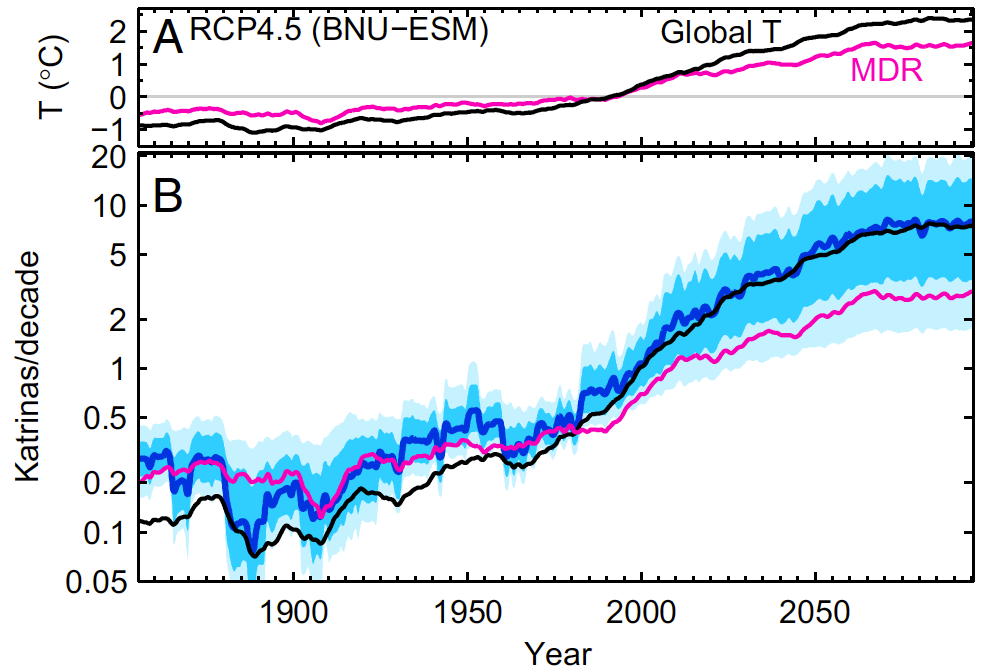The possible effect of global warming on the frequency or severity of cyclonic storms has been debated quite intensely among scientists (not only between scientists and climate change deniers) for over a decade. Several new studies are helping to clarify (somewhat) whether we are already experiencing (or will soon) more intense storms. Dana Nuccitelli has a nice summary of two of these new papers, excerpted below (see his full post here).
The link between human-caused global warming and extreme weather is often difficult to pin down, particularly with regards to hurricanes. As Kevin Trenberth has discussed, all weather now occurs in a climate that humans have altered.
“it is important to recognize that we have a “new normal,” whereby the environment in which all storms form is simply different than it was just a few decades ago. Global climate change has contributed to the higher sea surface and sub-surface ocean temperatures, a warmer and moisteratmosphere above the ocean, higher water levels around the globe, and perhaps more precipitation in storms.”
In a new paper, Grinsted et al. (2013) constructed a storm surge index beginning in 1923 from six long tide gauge records in the southeastern USA. The idea is that surges in sea level recorded at tide gauge stations can tell us about strong hurricane events. Consistent with their 2012 results, the authors found:
“The strong winds and intense low pressure associated with tropical cyclones generate storm surges. These storm surges are the most harmful aspect of tropical cyclones in the current climate, and wherever tropical cyclones prevail they are the primary cause of storm surges.”
They compared their storm surge index to changes in global surface temperature, to temperatures in the Main Development Region (MDR; a part of the Atlantic Ocean where most hurricanes form), and to MDR warming relative to the tropical mean temperatures (rMDR). They found that averaged sea surface temperatures over the MDR are the best predictor of Atlantic cyclone activity, followed by global average surface temperature, with MDR warming relative to the tropics being the worst predictor of hurricane activity (Figure 1).
rinsted et al. then used the relationships between hurricane storm surges and global and MDR temperatures to predict how storm surges will change in the future. They used the Representative Concentrations Pathway (RCP) 4.5 scenario, which represents a future in which we slowly reduce human greenhouse gas emissions such that they peak around the year 2040. In this scenario, there is approximately 2.4°C global surface warming over the 21st century. The results are shown in Figure 2.
“The response to a 1°C warming is consistently an increase [in Katrina-levelstorm surges] by a factor of 2–7 … This increase does not include the additional increasing surge threat from sea level rise”
 Figure 2: Number of Katrina magnitude surge events per decade (B) hindcast and projected changes in temperatures from climate model BNU-ESM under for RCP4.5 (A). The thick blue line shows the projection using the full spatial gridded temperatures andconfidence interval (5–16–84–95%); magenta and black show the projections using only Main Development Region (MDR) and global average surface temperature.
Figure 2: Number of Katrina magnitude surge events per decade (B) hindcast and projected changes in temperatures from climate model BNU-ESM under for RCP4.5 (A). The thick blue line shows the projection using the full spatial gridded temperatures andconfidence interval (5–16–84–95%); magenta and black show the projections using only Main Development Region (MDR) and global average surface temperature.
Also see a nice summary of Grinsted et al 2012 by Tamino here.
Leave a Reply